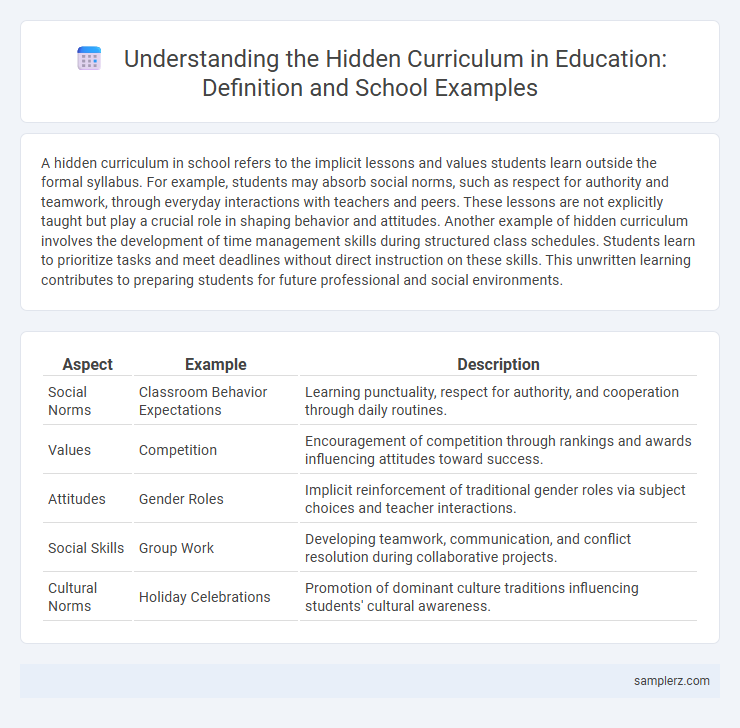A hidden curriculum in school refers to the implicit lessons and values students learn outside the formal syllabus. For example, students may absorb social norms, such as respect for authority and teamwork, through everyday interactions with teachers and peers. These lessons are not explicitly taught but play a crucial role in shaping behavior and attitudes. Another example of hidden curriculum involves the development of time management skills during structured class schedules. Students learn to prioritize tasks and meet deadlines without direct instruction on these skills. This unwritten learning contributes to preparing students for future professional and social environments.
Table of Comparison
| Aspect | Example | Description |
|---|---|---|
| Social Norms | Classroom Behavior Expectations | Learning punctuality, respect for authority, and cooperation through daily routines. |
| Values | Competition | Encouragement of competition through rankings and awards influencing attitudes toward success. |
| Attitudes | Gender Roles | Implicit reinforcement of traditional gender roles via subject choices and teacher interactions. |
| Social Skills | Group Work | Developing teamwork, communication, and conflict resolution during collaborative projects. |
| Cultural Norms | Holiday Celebrations | Promotion of dominant culture traditions influencing students' cultural awareness. |
Understanding Hidden Curriculum in Schools
Hidden curriculum in schools includes unspoken social norms, values, and behaviors that students learn beyond the formal syllabus, such as discipline methods, teacher expectations, and peer interactions. These elements influence students' social development, cultural understanding, and attitudes towards authority and collaboration. Recognizing hidden curriculum helps educators create more inclusive and equitable learning environments by addressing implicit biases and promoting positive social skills.
Social Norms and Behaviors Taught Indirectly
Hidden curriculum in schools often teaches social norms and behaviors indirectly through routines such as classroom seating arrangements, teacher-student interactions, and disciplinary practices. Students learn expectations about punctuality, respect for authority, cooperation, and competition without explicit instruction. These subtle lessons reinforce societal values and shape students' social skills essential for future interpersonal and professional environments.
Gender Roles Reinforced Through School Practices
School uniforms often reinforce traditional gender roles by requiring skirts for girls and pants for boys, implicitly signaling appropriate gender-specific attire. Classroom interactions may favor boys in participation and leadership, perpetuating stereotypes about assertiveness and competence. These practices subtly shape students' perceptions of gender roles, influencing their behavior and self-identity throughout their education.
Implicit Messages in Classroom Routines
Classroom routines often convey implicit messages that shape student behavior and social expectations, such as punctuality, respect for authority, and collaboration. These unspoken rules reinforce discipline and organizational skills without direct instruction, subtly influencing students' attitudes and values. For instance, consistent praise for raising hands before speaking implicitly teaches conformity and order within the learning environment.
Unwritten Rules in Student-Teacher Interactions
Hidden curriculum in education often includes unwritten rules in student-teacher interactions, such as expectations around eye contact, tone of voice, and body language. These subtle social cues influence students' understanding of respect, authority, and classroom behavior beyond formal lessons. Mastery of these implicit norms can significantly impact a student's academic success and social integration within the school environment.
Cultural Bias in School Traditions and Celebrations
School traditions and celebrations often reflect cultural biases by prioritizing dominant cultural narratives, which can marginalize minority students and obscure diverse perspectives. For example, holidays like Thanksgiving or Columbus Day celebrations may present a one-sided historical viewpoint, reinforcing ethnocentric ideals. This hidden curriculum implicitly teaches students whose culture is valued and shapes their understanding of social norms and identity within the educational environment.
Hierarchy and Authority within School Structures
Students learn about hierarchy and authority through school structures that establish clear roles for teachers, administrators, and students, emphasizing obedience and respect for rules. Classroom seating arrangements, teacher-centered instruction, and discipline policies subtly reinforce power dynamics and social stratification. This hidden curriculum shapes students' understanding of organizational norms and societal expectations beyond formal academic content.
Peer Influence and Social Group Dynamics
Peer influence shapes student behavior and attitudes, subtly reinforcing social norms and expectations outside formal lessons. Social group dynamics facilitate the development of interpersonal skills, such as cooperation, leadership, and conflict resolution, which are not explicitly taught. These hidden curriculum elements impact academic engagement and social integration throughout the school environment.
Expectations Conveyed Through Dress Codes
Dress codes in schools implicitly communicate expectations about professionalism, discipline, and conformity, shaping students' understanding of acceptable social behavior. These guidelines often reinforce gender roles and socioeconomic status, subtly influencing students' self-expression and peer interactions. By enforcing specific dress standards, schools convey norms that extend beyond explicit academic content to affect identity and social dynamics.
Impact of School Environment on Student Values
The hidden curriculum in schools shapes student values through implicit lessons conveyed by the school environment, such as classroom layouts, teacher attitudes, and peer interactions. These elements influence social norms, discipline, and cooperation expectations, often reinforcing societal hierarchies and cultural biases. Understanding this impact helps educators create inclusive environments that promote equity and holistic development beyond formal academic content.

example of hidden curriculum in school Infographic
 samplerz.com
samplerz.com